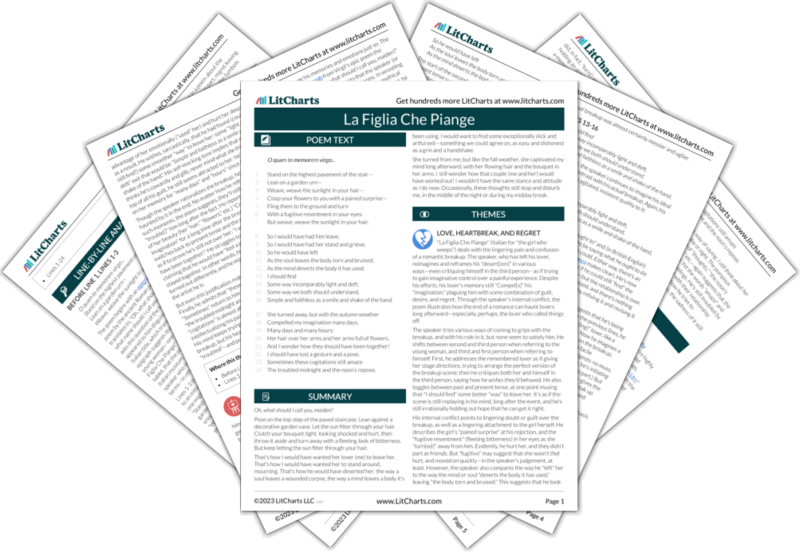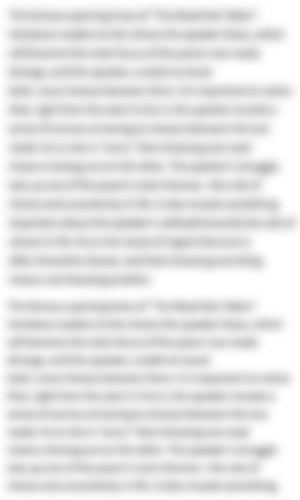
"La Figlia Che Piange" (Italian for "the girl who weeps") is the final poem in T. S. Eliot's first collection, Prufrock and Other Observations (1917). It's an unusual kind of breakup poem, one whose speaker remains both disturbed and strangely captivated by the memory of his breakup. Like a director restaging a scene, he tries reimagining the moment he "left" his lover, but nothing seems to assuage his guilt or regret. Nor can he seem to let go of his interest in the woman he disappointed, though he claims that staying with her would have meant the greater loss. Through its shifts in tense and perspective, the poem dramatizes the deep internal conflict that often follows the end of a romance.
|
Get
LitCharts
|

|
The Full Text of “La Figlia Che Piange”
O quam te memorem virgo...
1Stand on the highest pavement of the stair—
2Lean on a garden urn—
3Weave, weave the sunlight in your hair—
4Clasp your flowers to you with a pained surprise—
5Fling them to the ground and turn
6With a fugitive resentment in your eyes:
7But weave, weave the sunlight in your hair.
8So I would have had him leave,
9So I would have had her stand and grieve,
10So he would have left
11As the soul leaves the body torn and bruised,
12As the mind deserts the body it has used.
13I should find
14Some way incomparably light and deft,
15Some way we both should understand,
16Simple and faithless as a smile and shake of the hand.
17She turned away, but with the autumn weather
18Compelled my imagination many days,
19Many days and many hours:
20Her hair over her arms and her arms full of flowers.
21And I wonder how they should have been together!
22I should have lost a gesture and a pose.
23Sometimes these cogitations still amaze
24The troubled midnight and the noon’s repose.
The Full Text of “La Figlia Che Piange”
O quam te memorem virgo...
1Stand on the highest pavement of the stair—
2Lean on a garden urn—
3Weave, weave the sunlight in your hair—
4Clasp your flowers to you with a pained surprise—
5Fling them to the ground and turn
6With a fugitive resentment in your eyes:
7But weave, weave the sunlight in your hair.
8So I would have had him leave,
9So I would have had her stand and grieve,
10So he would have left
11As the soul leaves the body torn and bruised,
12As the mind deserts the body it has used.
13I should find
14Some way incomparably light and deft,
15Some way we both should understand,
16Simple and faithless as a smile and shake of the hand.
17She turned away, but with the autumn weather
18Compelled my imagination many days,
19Many days and many hours:
20Her hair over her arms and her arms full of flowers.
21And I wonder how they should have been together!
22I should have lost a gesture and a pose.
23Sometimes these cogitations still amaze
24The troubled midnight and the noon’s repose.
-
“La Figlia Che Piange” Summary
-
-
“La Figlia Che Piange” Themes
-

Love, Heartbreak, and Regret
- See where this theme is active in the poem.
-

Emotional Attachment vs. Aesthetic Detachment
- See where this theme is active in the poem.
-
-
Line-by-Line Explanation & Analysis of “La Figlia Che Piange”
-
Before Line 1, Lines 1-3
O quam te memorem virgo...
Stand on the highest pavement of the stair—
Lean on a garden urn—
Weave, weave the sunlight in your hair— -
Lines 4-7
Clasp your flowers to you with a pained surprise—
Fling them to the ground and turn
With a fugitive resentment in your eyes:
But weave, weave the sunlight in your hair. -
Lines 8-12
So I would have had him leave,
So I would have had her stand and grieve,
So he would have left
As the soul leaves the body torn and bruised,
As the mind deserts the body it has used. -
Lines 13-16
I should find
Some way incomparably light and deft,
Some way we both should understand,
Simple and faithless as a smile and shake of the hand. -
Lines 17-20
She turned away, but with the autumn weather
Compelled my imagination many days,
Many days and many hours:
Her hair over her arms and her arms full of flowers. -
Lines 21-24
And I wonder how they should have been together!
I should have lost a gesture and a pose.
Sometimes these cogitations still amaze
The troubled midnight and the noon’s repose.
-
-
“La Figlia Che Piange” Symbols
-

The Urn
- See where this symbol appears in the poem.
-

Garden/Flowers
- See where this symbol appears in the poem.
-
-
“La Figlia Che Piange” Poetic Devices & Figurative Language
-
Apostrophe
- See where this poetic device appears in the poem.
-
Repetition
- See where this poetic device appears in the poem.
-
Simile
- See where this poetic device appears in the poem.
-
Enjambment
- See where this poetic device appears in the poem.
-
Irony
- See where this poetic device appears in the poem.
-
-
“La Figlia Che Piange” Vocabulary
Select any word below to get its definition in the context of the poem. The words are listed in the order in which they appear in the poem.
- Pavement
- Urn
- Fugitive
- Incomparably
- Faithless
- Compelled
- Pose
- Cogitations
- Amaze
- Repose
-
- See where this vocabulary word appears in the poem.
-
Form, Meter, & Rhyme Scheme of “La Figlia Che Piange”
-
Form
-
Meter
-
Rhyme Scheme
-
-
“La Figlia Che Piange” Speaker
-
-
“La Figlia Che Piange” Setting
-
-
Literary and Historical Context of “La Figlia Che Piange”
-
-
More “La Figlia Che Piange” Resources
-
External Resources
-
The Poet's Life and Work — A short biography of Eliot at The Poetry Foundation.
-
An Introduction to Modernism — A Poetry Foundation feature on the movement Eliot helped define.
-
The Poet's Love Life — An article about the complex romantic relationships that inspired Eliot's poems.
-
An Original Printing — See the poem as it originally appeared in Prufrock and Other Observations (1917).
-
The Poem Aloud — Listen to T. S. Eliot read "La Figlia Che Piange."
-
-
LitCharts on Other Poems by T. S. Eliot
-















